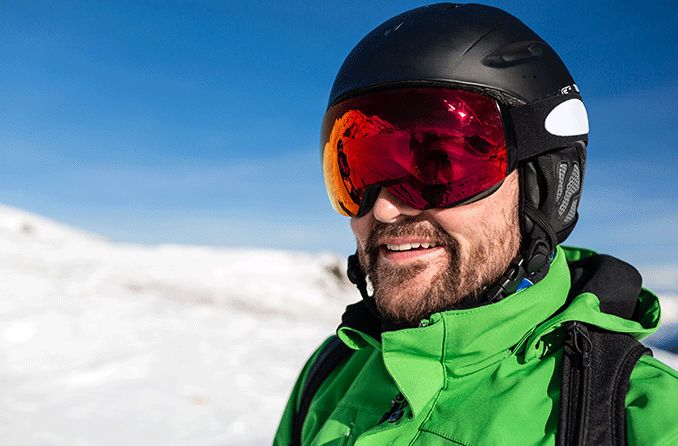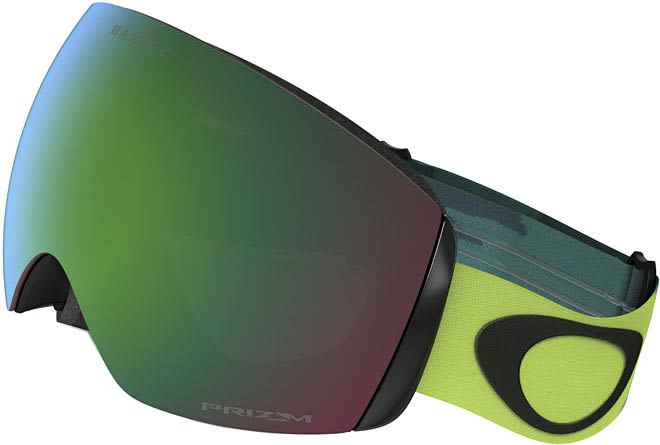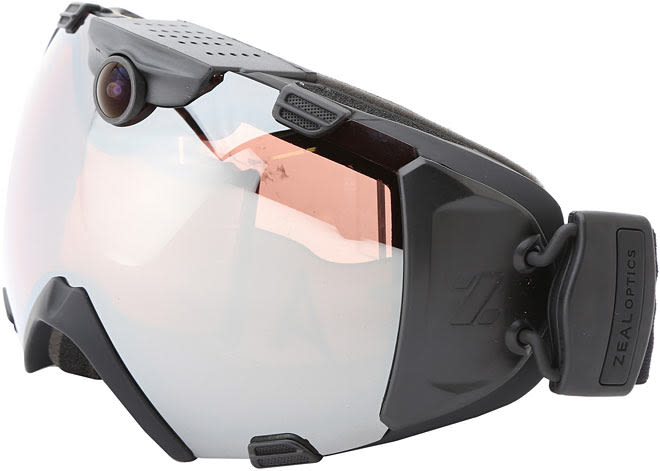Ski goggles: A buyer's guide for skiers and snowboarders

The last time I bought ski goggles, I walked into a mountain resort shop, looked at the three models they had in the case, and picked one at random.
Which wasn't really very smart of me, because:
They don't fit very well.
The lens color was all wrong for the cloudy Vermont mountain where I was skiing.
They're not compatible with my helmet.
They cost too much.
If you want to avoid my experience, read these 12 tips for getting great eye protection, no matter which winter sport you're into:
1. Shop before you get to the mountain.
Try a well-stocked sporting goods store, ski and boarding shop or specialty optical store. You'll probably pay less, and you'll have more time to make a smart decision.
Don't shop at a snow resort unless you have to. There are exceptions, but many resorts have a limited selection and inflated prices.
2. Don't be shy — ask questions.
There are so many different products and features out there that it can be hard to choose. You need a salesperson who has worn them and knows which lenses work best in which conditions.
If the clerk seems uninformed or unwilling to answer questions, try a different store.
You can also look on the Internet. Most of the big snow goggle manufacturers provide a lot of product details on their websites.
3. Take your time, and try on as many goggles as you can.
And take them outside (with the clerk's permission), to see how well the lenses work in natural light.
If you're buying clear lenses for night skiing or riding, test them in a dark room with one light bulb on. You want to make sure they'll be distortion- and glare-free when you look at lights along the trail or the half-pipe.
Don't make a snap decision, because the wrong equipment can ruin your day or evening in the snow. And those lift tickets are expensive!
4. Choose the right lens tint.
Weather, terrain and activity all come into play here. Think about where you usually ski or ride: Is the mountain sunny in the morning, the afternoon or all day? Do you like smooth trails or more challenging areas like moguls, terrain parks and trees?
Your goal is to get the tint that will provide a good combination of color definition, contrast, depth perception and eye fatigue protection, all with the right visible light transmission (VLT) for your light conditions.
A low VLT number such as 15 percent means less eye fatigue on sunny days. And a high VLT number such as 70 percent means better color and depth perception on low-light days.
In low light and fog, yellow, gold and amber lenses filter out blue light, emphasizing shadows in the snow so you can see bumps better. They also work well in moderate and variable light conditions.
Light rose and rose copper lenses are also excellent on low-light days.
In bright light, dark tints such as copper, dark brown, dark gray and dark green will keep your eyes more comfortable while they increase contrast. Gray lenses are also good for letting you see true colors.
A mirror (or "flash") coating enhances the effectiveness of tinted lenses by reflecting sunlight so it doesn't penetrate the lens. This lowers the VLT of the lens and makes it a great choice for bright, sunny days.
For sunset and nighttime, use only clear lenses, since they have the highest VLT, allowing the most light to come into your eyes.
Consider goggles with photochromic lenses, which become lighter or darker automatically, as the light changes. Usually they are available in either gray or brown.
Interchangeable lenses are becoming more common in ski goggles and sports sunglasses. They let you switch lenses when light conditions change.

Several manufacturers offer ski goggles specifically for faces with shallow nose bridges and high cheekbones. Shown is the Asia Fit version of Oakley Flight Deck XM Prizm with a rimless design.
Check out the lens color charts on the websites of ski goggle manufacturers. It can be difficult to choose among the many lenses available now, but the manufacturers' charts usually specify how much VLT the tints provide and which light conditions they work for best.
In fact, when choosing a ski goggle, look at lens features first. Lenses are the most important part — everything else is either the support system or the fashion statement.
5. Protect your eyes from glare.
Polarized lenses reduce glare from sunlight reflecting off the slopes and are great when it's bright out. But they may not be ideal near the end of the day when long shadows appear in the snow, because they usually are made with a darker tint than most sun lenses.
6. Insist on ultraviolet light protection.
UVA and UVB are the most important rays to guard against. Too much exposure to UV on a short-term basis can give you a painful sunburn on your eyes, called photokeratitis. Long-term, UV rays can damage your eyes permanently and may lead to cataracts and other eye diseases. Look for goggles and sunglasses that block 100 percent of these rays, which bounce off the snow and into your eyes even on cloudy days.
7. Look for good peripheral vision.
Newer, lower-profile styles fit better with a helmet and look cooler than traditional styles with large lenses. But if you choose the low-profile look, make sure you have enough peripheral (side) vision — some goggles skimp out on that.
Ideally, you should be able to see 180 degrees from side to side, to help you avoid skiers and riders. If you prefer sunglasses, choose a wrap style with the least amount of distortion at the sides that you can find.
8. Make sure the goggles fit.
Take the time to adjust the strap to properly fit your head. If the strap is a complete pain to adjust, or if the buckle doesn't stay in adjustment, move on.
Make sure they will fit with or without a helmet. Even if you don't use one now, you may in the future.
Some styles have softer, more rubbery buckles that won't dig into your scalp. Wider bands are more comfortable than narrower ones. And foam inserts keep out wind, ice and dirt. The foam should be thick enough to help cushion your face if you fall, but not so dense that it encourages fogging. The salesperson should be able to help you make this judgment.
If you have high cheekbones and/or a shallow nose bridge, consider a goggle that's designated "Asian fit." Manufacturers are also producing more goggles for narrow and extra-wide faces.
If you wear glasses, make sure the goggles will fit over them. Some goggles are designed just for this. And many optical stores, especially those near ski areas, will make up prescription inserts for goggles that can accept them, so you won't need glasses at all.
Wrap-style sunglasses and ski goggles can't always accept prescription lenses because of the frame's extreme curvature. An optician will know which frames are prescription-suitable and will be able to order and fit them for you.

Bring an anti-fogger, such as these Defog It dry anti-fog cloths in a resealable pouch. Other options are anti-fog solutions (let them dry before you start) and fog erasers that include a sponge on one side and a soft cloth on the other side.
9. Look for anti-fogging features.
Choose goggles with double lenses that discourage condensation from forming when the warm air of your breath makes contact with the cold lens. Anti-fog coating inside the goggles helps, while vents along the sides, top and bottom clear the warm air out of the inside of the goggles.
Wider vents tend to do this better than narrow vents or tiny vent holes. But the drawback of wide vents is that your face will get cold in a harsher climate.
At least two manufacturers have goggles with tiny fans; they suck in air through one set of vents and send it out through another set. The fans are light, though they do require a AAA battery. Sounds worth a try if fogging is a big problem for you.
10. Make safety a priority.
Most goggles and sunglasses made for fast-moving winter sports have polycarbonate lenses; this material is much more impact-resistant than regular plastic. If you have prescription inserts, you'll want these to be made of polycarbonate as well.
Also, the more flexible the frame and lens, the less likely the lens will break or pop out in a bad fall. Foam inserts at all impact points are important. Some manufacturers now use polar fleece as padding; it's cushiony and warm, and it does a good job of wicking sweat from your skin if you become overheated.
For sunglasses, look for polycarbonate or other impact-resistant frame materials rather than metals. Adjustable rubber earpieces and nosepieces will keep them on better when you're tackling bumps and might be more comfortable than hard plastic ones that don't adjust.
11. Look for nice-to-have features.
A scratch-resistant coating will help your goggles and sunglasses last longer, especially if you like glade runs where there's a lot of brush or you tend to fall a lot. Always keep your eyewear in a soft pouch or lined case when not in use.

This Zeal Optics Base goggle has a built-in camera and HD video recorder so you can easily capture your wildest rides down the slopes.
Some ski goggles have nose guards designed for warmth and to protect your nose in a fall. However, a warm nose might contribute to fogging, and landing on a hard nose guard might be just as bad for your nose as landing on the snow's surface. So consider your skiing or riding style before buying this type of goggle.
The ability to shoot photos and videos is available on some new models. You can also get goggles with built-in GPS. This lets you track your speed, altitude, location, jump stats and more — all in real time.
And if you're super-picky about how your goggles look, consider customizable ones that let you choose the frame color, strap pattern, lens tint and more. In fact, Oakley will even etch the lenses with words of your choosing.
12. Understand the warranty and return policy.
Many stores will take returns only on undamaged goggles, with no scratches on the lenses. So be sure not to scratch the lenses the first time out. Bring an older goggle so you can use it for the rest of the day if you don't like the new one.
Some manufacturers will replace your lenses (usually for a fee) if you send them the goggles or sunglasses.
See you on the slopes!
READ NEXT: Best ski goggles and best sunglasses for skiing
Page published on Wednesday, February 27, 2019







